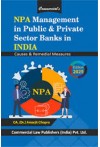- Author(s): Amarjit Chopra
- Publisher: Commercial Law Publishers (India) Pvt Ltd
- Edition: Ed 2025
- ISBN 13 9789356032101
- Approx. Pages 252 + Contents
- Format Hardbound
- Approx. Product Size 24 x 16 cms
- Delivery Time 3-5 working days (within Kerala & South India) (Others 7-9 days)
- Shipping Charge Extra (see Shopping Cart)
......................................................................................................................................
Description
Indian banking industry is faced with the serious problem of huge amount of nonperforming Assets (NPAs). Banks big or small, public or private all are projects have contributed in a large measure to the kitty of NPAs. It appears carrying the burden of NPAs in all sectors of economy. Infrastructure greening of accounts was resorted to in a big way by the banks and financial institutions till the time RBI cracked its whip and undertook Asset Quality Review across the banking system and this brought to surface the ground reality of NPA problem.
that ever
The incidence of non-performing assets (NPAs) is affecting the performance of the credit institutions both financially and psychologically. Non-performing assets (NPA) in many ways have rendered banks and bankers to be non-performing as these have:
· Prevented or delayed recycling of funds.
Delayed income receipt and recognition of interest on such assets. Erosion of profits by way of huge provisions.
RBI has laid down prudential norms for classification of assets, income recognition and provisioning. Generally, an asset has to be classified as Non- Performing in case the borrower defaults on payment of interest and/or principal for a period exceeding 90 days. This applies to term loans and bills discounted/ purchased by banks. In case of working capital limits, if the account remains irregular for a period exceeding 90 days the account is classified as NPA. Irregular account means one in which the limits are exceeded from sanctioned limits or the drawing power. Also, in these loans if the interest remains unserviced in total or in part, the account is classified as non-performing.
NPA is a disorder resulting in non-performance of a portion of loan portfolio leading to non- recovery or under recovery of principal and/or income to the lender. NPAs represent the quantified "Credit Risk". All this also plays havoc on the mental make-up of the banker where in the banker tries to go slow on lending, fearing future NPAs, which may lead to delay and denial of credit resulting in low off- take of lendable funds. NPAs are a burden on the banking industry. Success and health of a bank depends upon the methods of managing NPAs and keeping them within tolerance level.
Banks need to monitor their standard assets regularly for early detection of the weaknesses in the accounts and to take appropriate measures to prevent them slipping to NPA category.
......................................................................................................................................
Table of Contents
Chapter 1. Introduction to Non - Performing Assets (NPAs)
Chapter 2. Recoveries under Insolvency and Bankruptcy Code, 2016
Chapter 3. Profile of Banks
Chapter 4. Research Methodology
Chapter 5. Analysis of Performance Indicators of Banking Sector
Chapter 6. Measures to Resolve the NPA Issues
......................................................................................................................................
Author Details
Born in June 1952, Amarjit Chopra did his graduation and post graduation from Delhi University in the years 1971 and respectively. He qualified as Chartered Accountant in the year 1975 and has been in the profession for a period of more than 46 years. He is a senior partner in GSA & Associates LLP Chartered Accountants New Delhi. He was also
engaged in teaching at Deshbandhu (Eve.) College, a Delhi University maintained college for nearly 23 years.
He was elected to Northern India Regional Council of ICAI for two terms 1985-88 and 1988-91 and was its Chairman for the year 1988-89. He was elected to Central Council of ICAI for five consecutive terms of three years each beginning 1998 and ending 2013.He was elected as President of ICAI for the year 2010-11 and Vice President for the year before. During his term as Central Council Member he was member of various Standing and Non Standing Committees of ICAI. He Chaired some of the most significant Committees namely Accounting Standards Board, Auditing and Assurance Standards Board, Financial Reporting Review Board, Corporate Laws Committee, Expert Advisory Committee, Disciplinary Committee, Executive Committee, Examination Committee etc.
He was nominated by Govt of India on the Board of Bank of Baroda (2006-09), Indian Bank (2011-14), Garden Reach Ship Builders and Engineers Ltd (2011-14). He chaired Audit Committees of all the aforesaid companies. He was also on the Board of Insurance and Regulatory Authority (IRDA), South Asian Federation of Accountants, Confederation of Pacific Accountants for the year 2010-11. He was a member of the Committee on Accounting Issues of Insurance Companies constituted by IRDA.
He was nominated by Central Govt. as the Chairman of National Advisory Committee on Accounting Standards for a period of four years from 2014-18. During his this tenure Ind As equivalent to IFRS were introduced in the country. As Chairman Accounting Standards Board of ICAI he introduced IFRS certificate course and organised and participated in IFRS training programmes in Middle East, Nepal, Bhutan, Mynmmar and India. He was also nominated by Govt of India as member of Investor Education Protection Authority. He Chaired the Committee constituted by Govt to revise Manufacturing and Other Companies Auditors Report Order (MAOCARO) in 2003 and to revise Companies Auditor's Report Order (CARO) in the year 2019.

